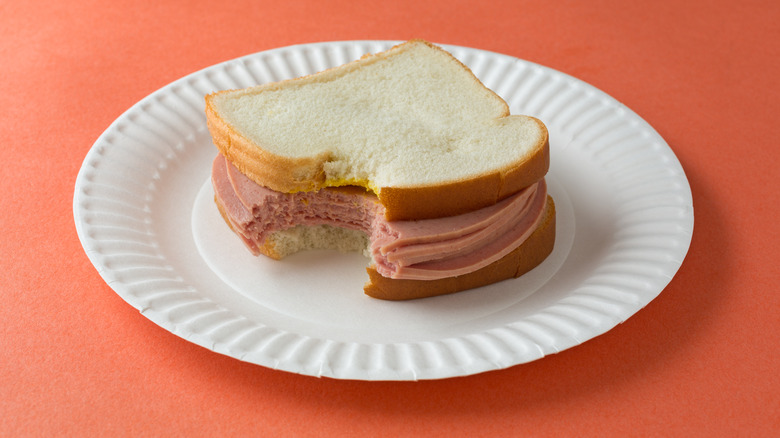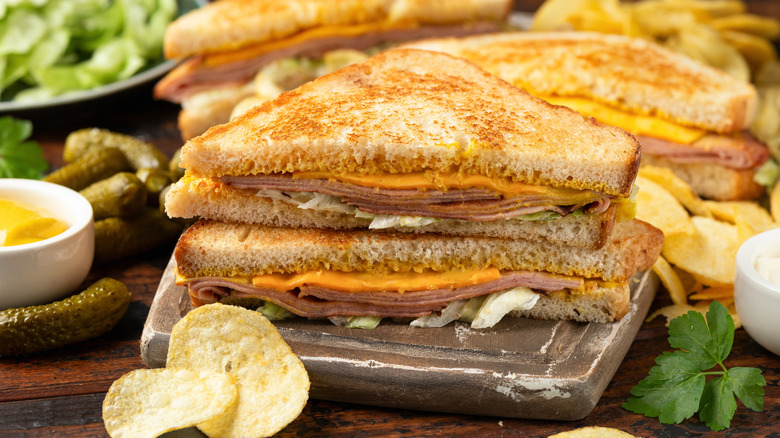How Bologna Sandwiches Became A Lunch Time Staple
If you were a kid before the mid-1990s, bologna sandwiches — served cold or fried, with tomato slices and mayo on white bread — were almost certainly on the menu. You may even remember a parent or grandparent wrapping up the same sandwich to take to work for their lunch. The bologna sandwich can evoke comforting, nostalgic memories or revulsion at the mundanity of basic, mushy ingredients. Either way, for much of the 20th century, the bologna sandwich was a definitive lunchtime staple. It still pops up on restaurant menus from time to time, including being highlighted at Louisville, Kentucky's Gralehaus; one of the "Diners, Drive-Ins, and Dives" restaurants that are definitely worth a visit. Even today, it lives on as a family favorite in many homes.
How did bologna — as opposed to, say, salami — become such a standard sandwich filling for everyone from school kids to office workers? As with most classic dishes in the United States, it's an immigrant tale, tweaked and given a distinctly American twist. Bologna is essentially a descendent of mortadella which hails from Bologna, Italy (hence the name). It's thought that German immigrants brought it to America in the 19th century along with frankfurters or hot dogs and other sausages. With the rise of packaged, mass-produced foods in the early and mid-20th century, bologna (or baloney) quickly became a common, affordable item in every icebox and refrigerator.
Bologna, baloney, and mortadella are closely related
The USDA classifies bologna as a "cooked and/or smoked sausage." Bits of beef, pork, or chicken are heated and blended into a uniform paste and eventually formed into the pink discs most of us now know as bologna. In the U.S., the paste must be uniform with no visible fats and contain specific proportions of meats, fats, water, and non-meat binders.
But it didn't start that way. In the Italian city of Bologna, the similar but more flavorful antecedent, mortadella, has been filling bellies for millennia, based on historical and archaeological records. Mortadella is actually a labor-intensive, high-quality meat. Mincing meat by hand took skill, and seasonings are specific. The process was officially codified by the papacy in 1661 and even today, Italian mortadella follows strict production rules: It must feature high-quality pork (no other meats), and have visible blocks of fat, meat, and spices.
Bologna became the unofficial name for similar fine-chopped sausages that couldn't legally be called mortadella. Baloney, it turns out, is an Americanism. It stemmed from the word bologna somewhere in the mid-1800s, appearing in humorous dialect-based songs and articles. It wasn't until the 1920s that the term also came to mean falsehood. Though a popular 1970s Oscar Mayer ad featured a child singing about the first name of their "baloney," the product itself is labeled as bologna.
Bologna sandwiches are still everywhere
In the 20th century, a confluence of events — the Great Depression, a rise in the popularity of sandwiches as a meal in the 1920s, and the proliferation of the deli meat slicer — helped drive bologna to the forefront of sandwich meats. Following World War II, processed, packaged items became more desirable — and by the mid-1960s, school lunch programs included bologna sandwiches. A few years later, former VP of marketing, Jerry Ringlien, said Oscar Mayer was selling as much bologna as it was hot dogs.
Other institutions including the prison system also incorporated bologna sandwiches. They were provided to Mexican farm laborers, brought to America through the Braceros program in the '40s and '50s. Researchers on the submersible Alvin even packed bologna sandwiches for a failed deep-sea expedition in 1968. By the late '90s, sales began to decline as people shifted to meals they perceived as healthier. Still, bologna sales continue to experience upticks during economic recessions.
All in, bologna still has plenty of fans. At Lil Red — a James Beard-nominated, Black-owned barbecue joint in Seattle — you'll sometimes find smoked, fried bologna sandwiches on the menu, alongside Jamaican spiced jerk pork and curry chicken. At Salty Lunch Lady's Little Luncheonette in Queens, New York, you can enjoy an elevated bologna (It's really more of a mortadella) sandwich on crusty bread, with aged provolone. And Robert's Western World in Nashville offers The Recession Special: A fried bologna sandwich, chips, Moon Pie, and Pabst Blue Ribbon beer for $6. Or, elevate your sandwich the Southern way: Fried, with plenty of fixings.


